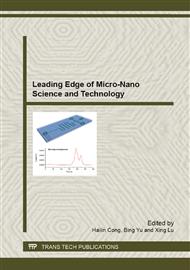[1]
M. Whittle, W.A. Bullogh, The structure of smart fluids, Nature 358 (1992) 373.
Google Scholar
[2]
W.M. Winslow, Induced fibrillation of suspensions, J. Appl. Phys. 20 (1949) 1137-1140.
Google Scholar
[3]
T.C. Halsey, Electrorheological fluids, Science 258 (1992) 761-766.
Google Scholar
[4]
T. Hao, Electrological fluids, Adv. Mater. 13 (2001)1847-1857.
Google Scholar
[5]
B.X. Wang, X.P. Zhao, Preparation of kaolinite/titania coated nanocomposite particles and their electrorheological properties, J. Mater. Chem. 13 (2003) 2248-2253.
DOI: 10.1039/b305718f
Google Scholar
[6]
J.W. Kim, Y.H. Cho, H.G. Lee, S.B. Choi, Electrorheological SemiActive Damper: Polyaniline Based ER System, J. Intell. Mater. Syst. Struct. 13 (2002) 509-513.
Google Scholar
[7]
W.J. Wen, X.X. Huang, S.H. Yang, K.Q. Lu, P. Shen, The giant electrorheological effect in suspensions of nanoparticles, Nat. Mater. 2 (2003) 727-730.
DOI: 10.1038/nmat993
Google Scholar
[8]
K.Q. Lu, R. Shen, X.Z. Wang, G. Sun, W.J. Wen, J.X. Liu, Polar molecule dominated electrorheological effect, Chin. Phys. 15 (2006) 2476.
Google Scholar
[9]
J.B. Yin, X.P. Zhao, Giant electrorheological activity of high surface area mesoporous cerium-doped TiO2 templated by block copolymer, Chem. Phys. Lett. 398(2004) 393-399.
DOI: 10.1016/j.cplett.2004.09.098
Google Scholar
[10]
W.J. Wen, X.X. Huang, P. Sheng, Electrorheological fluids: structures and mechanisms, Soft Matter. 4(2008) 200-210.
DOI: 10.1039/b710948m
Google Scholar
[11]
K.Q. Lu, R. Shen, X.Z. Wang, G. Sun, Polar molecule type electrorheological fluids, Int. J. Mod. Phys. B. 21 (2007) 4798.
DOI: 10.1142/s0217979207045682
Google Scholar
[12]
C.J. Gow, C.F. Zukoski IV, The electrorheological properties of polyaniline suspensions, J. Colloid Interface Sci. 136 (1990) 175-188.
DOI: 10.1016/0021-9797(90)90088-6
Google Scholar
[13]
H.Q. Xie, J.G. Guan, Study on electrorheological properties of semiconducting polyaniline-based suspensions, Angew. Makromol. Chem. 235 (1996) 21-34.
Google Scholar
[14]
H.J. Choi, T.W. Kim, M.S. Cho, S.G. Kim, M.S. Jhon, Electrorheological characterization of polyaniline dispersions, Eur. Polym. J. 33 (1997) 699-703.
DOI: 10.1016/s0014-3057(96)00225-x
Google Scholar
[15]
H.J. Choi, J.W. Kim, K. To, Electrorheological characteristics of semiconducting poly(aniline-co-o-ethoxyaniline) suspension, Polymer. 40 (1999) 2163-2166.
DOI: 10.1016/s0032-3861(98)00418-2
Google Scholar
[16]
J. Jiang, L.C. Li, M.L. Zhu, Polyaniline/magnetic ferrite nanocomposites obtained by in situ polymerization, React. Funct. Polym. 68 (2008) 57-62.
DOI: 10.1016/j.reactfunctpolym.2007.10.010
Google Scholar
[17]
A. Lengá lová, V. Pavlí nek, P. Sá ha, J. Stejskal, T. Kitano, O. Quadrat, The effect of dielectric properties on the electrorheology of suspensions of silica particles coated with polyaniline, Physica A. 321 (2003) 411-424.
DOI: 10.1016/s0378-4371(02)01734-x
Google Scholar
[18]
S.P. Armes, S. Gottesfeld, J.G. Beery, F. Garzon, S.F. Agnew, Conducting polymer-colloidal silica composites, Polymer. 32 (1991) 2325-2330.
DOI: 10.1016/0032-3861(91)90068-t
Google Scholar
[19]
N. Kuramoto, M. Yamazaki, K. Nagai, K. Koyama, K. Tanaka, K. Yatsuzuka, Electrorheological property of a polyaniline-coated silica suspension, Thin Solid Films. 239 (1994) 169-171.
DOI: 10.1016/0040-6090(94)90845-1
Google Scholar
[20]
A. Gromov, V. Korenivski, Electromagnetic analysis of layered magnetic/conductor structures, J Phys D: Appl. Phys. 33 (2000) 773.
DOI: 10.1088/0022-3727/33/7/304
Google Scholar
[21]
J. Stejskal, O. Quadrat, I. Sapurina, J. Zemek, A. Drelinkiewicz, M. Hasik, I. Krivka, J. Prokes, Polyaniline-coated silica gel, Eur. Polym. J. 38 (2002 ) 631-637.
DOI: 10.1016/s0014-3057(01)00241-5
Google Scholar
[22]
K.G. Neoh, K.K. Tan, P.L. Goh, S.W. Huang, E.T. Kang, K.L. Tan, Electroactive polymer-SiO2 nanocomposites for metal uptake, Polymer. 40 (1999) 887-893.
DOI: 10.1016/s0032-3861(98)00297-3
Google Scholar
[23]
S.W. Huang, K.G. Neoh, E.T. Kang, H.S. Han, K.L. Tan, Palladium-containing polyaniline and polypyrrole microparticles, J. Mater. Chem. 8 (1998)1743-1748.
DOI: 10.1039/a802245c
Google Scholar
[24]
R. Shen, X.Z. Wang, W.J. Wen, K.Q. Lu, TiO2 based electrorheological fluid with high yield stress, Int. J. Mod. Phys. B. 19 (2005), 1104.
DOI: 10.1142/s0217979205029924
Google Scholar
[25]
V. Pavlínek, P. Sáha, T. Kitano, J. Stejskal, O. Quadrat, The effect of polyaniline layer deposited on silica particles on electrorheological and dielectric properties of their silicone–oil suspensions, Physica A. 353 (2005) 21-28.
DOI: 10.1016/j.physa.2005.01.033
Google Scholar


